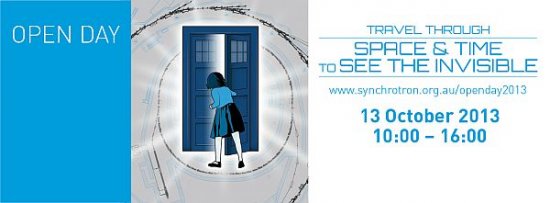An opportunity to see the eye of a machine that can ‘see the invisible’, help develop the human bionic eye, and create some of the most inspiring capabilities of humans to investigate our world, is available in October, at Australia’s largest particle accelerator, the Australian Synchrotron.

The Australian Synchrotron is a world-class research support facility that produces an intense light, a million times brighter than the sun, using an MCG-sized circular particle accelerator. The light enables industry, universities and other research institutions around Australia, to see the invisible: the composition and interactions of matter, almost invisible to other laboratory techniques.
The Synchrotron’s annual Open Day is on Sunday 13 October, providing a once-a-year opportunity for access to the facility, and experts that use this world-class research instrument.
With the help of the popular TV sitcom Big Bang Theory, the discovery of the ‘god particle’ early this year by the largest synchrotron in the world, the Large Hadron Collider, and even Iron Man who built his own synchrotron, many people are more aware of the cutting-edge capabilities of these powerful machines. Open Day aims to help Australians understand what synchrotron facilities are doing for our everyday lives, and be very proud of having their own.
The Australian Synchrotron’s x-ray and infra-red light is so powerful, it’s able to observe chemical reactions, see detail within a human blood cell, and discover the structure of molecules that are responsible for the mechanisms of life.
Recently, the facility’s expert scientific teams, supported ‘users’ of the synchrotron in creating the world’s first images of insulin in action, observing how milk binds with iron and helped to discover the ‘assassin protein’ which kills pre-cancerous and viruses-infected cells in the body on a daily basis.
Other investigations by the Synchrotron and its teams have significantly contributed to:
- designing materials that provide targeted drug delivery to parts of the body that need it
- determining how to make, store and use hydrogen as an efficient and sustainable fuel source
- developing a technique with the potential to destroy tumours in limbs; potentially avoiding amputation
- discovering techniques to turn waste products into new resources – for example a low-carbon concrete produced from the by-product of coal combustion
- revealing artworks hidden under layers of normally impenetrable lead
- investigating better ways to capture and store carbon dioxide, and
- helping produce fully biodegradable plastics.
The annual Open Day activities include specialist-guided tours, a series of expert talks (including how industry is using the synchrotron), self-guided tours around the beamlines, an art/science exhibition space, young kids’ activities and older kids’ hands-on laboratory sessions. There will be scientists available at each of the nine experimental stations (or beamlines), to tell stories about what they see everyday, that no one else can. The imaging and medical beamline (IMBL) will display 3D videos of the mind-blowing images it can produce for researchers (see link below).
There will also be an education showcase, helping aspiring scientists find out how they could become a synchrotron scientist and give the Big Bang Theory team a run for their money!
3D x-ray of rat heart (IMBL): http://bit.ly/ASratheartIMBL
Open Day flyer: http://bit.ly/ASOpenDayFlyer
General introduction video to the Synchrotron (Youtube – 12min): http://bit.ly/ASynchResearch
Media liaison: Sarah Bartlett 0403 225 872
Media contact: Prof Andrew Peele, Interim Director, 0408 388 467
